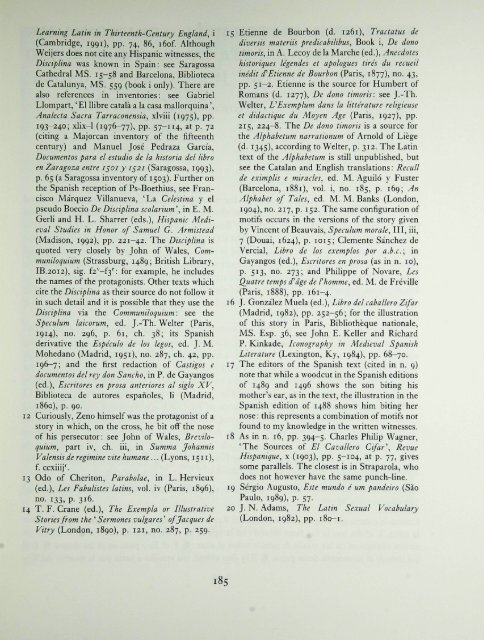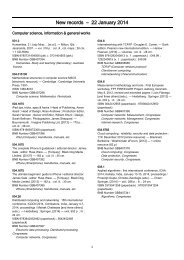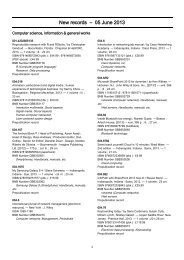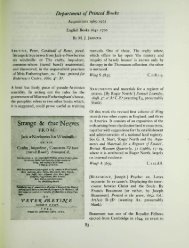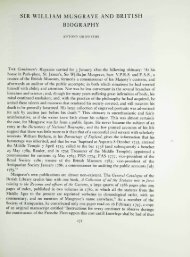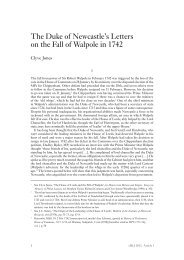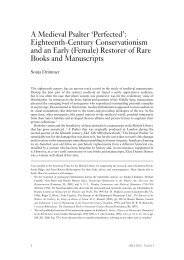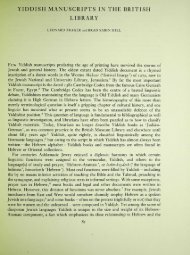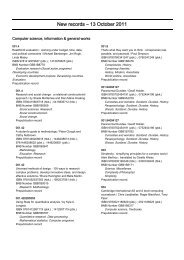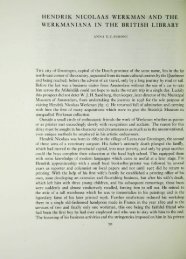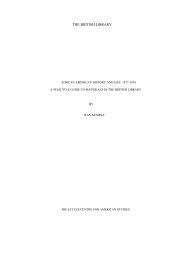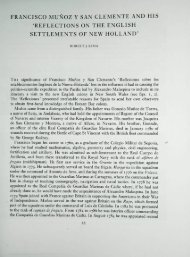AN OLD SPANISH TALE FROM ADD. MS. 14040, flf ... - British Library
AN OLD SPANISH TALE FROM ADD. MS. 14040, flf ... - British Library
AN OLD SPANISH TALE FROM ADD. MS. 14040, flf ... - British Library
You also want an ePaper? Increase the reach of your titles
YUMPU automatically turns print PDFs into web optimized ePapers that Google loves.
Learning Latin in Thirteenth-Century England, i<br />
(Cambridge, 1991), pp. 74, 86, i6of. Although<br />
Weijers does not cite any Hispanic witnesses, the<br />
Disciplina was known in Spain: see Saragossa<br />
Cathedral <strong>MS</strong>. 15-58 and Barcelona, Biblioteca<br />
de Catalunya, <strong>MS</strong>. 559 (book i only). There are<br />
also references in inventories: see Gabriel<br />
Llompart,' El lhbre catala a la casa mallorquina',<br />
Analecta Sacra Tarraconensia, xlviii {1975), pp.<br />
193-240; xlix-1 (1976-77), pp. 57-114, at p. 72<br />
(citing a Majorcan inventory of the fifteenth<br />
century) and Manuel Jose Pedraza Garcia,<br />
Documentos para el estudio de la historia del libro<br />
en Zaragoza entre 1501 y 1521 (Saragossa, 1993),<br />
p. 65 (a Saragossa inventory of 1503). Further on<br />
the Spanish reception of Ps-Boethius, see Francisco<br />
Marquez Villanueva, 'La Celestina y el<br />
pseudo Boecio De Disciplina scolarium', in E. M.<br />
Gerli and H. L. Sharrer (eds.), Hispanic Medieval<br />
Studies in Honor of Samuel G. Armistead<br />
(Madison, 1992), pp. 221-42. The Disciplina is<br />
quoted very closely by John of Wales, Communiloquium<br />
(Strassburg, 1489; <strong>British</strong> <strong>Library</strong>,<br />
IB.2012), sig. f2'-f3'': for example, he includes<br />
the names ofthe protagonists. Other texts which<br />
cite the Disciplina as their source do not follow it<br />
in such detail and it is possible that they use the<br />
Disciplina via the Commumloquium: see the<br />
Speculum laicorum, ed. J.-Th. Welter (Paris,<br />
1914), no. 296, p. 61, ch. 38; its Spanish<br />
derivative the Especulo de los legos, ed. J. M.<br />
Mohedano {Madrid, 1951), no. 287, ch. 42, pp.<br />
196-7; and the first redaction of Castigos e<br />
documentos del rey don Sancho, in P. de Gayangos<br />
(ed.), Escritores en prosa anteriores al siglo XV,<br />
Biblioteca de autores espanoles, Ii {Madrid,<br />
i860), p. 90.<br />
12 Curiously, Zeno himself was the protagonist of a<br />
story in which, on the cross, he bit off the nose<br />
of his persecutor: see John of Wales, Breviloquium,<br />
part iv, ch. iii, in Summa Johannis<br />
Valensis de regimine vite humane... {Lyons, 1511),<br />
f. ccxiiij'".<br />
13 Odo of Cheriton, Parabolae, in L. Hervieux<br />
(ed.), Les Fabulistes latins, vol. iv (Paris, 1896),<br />
no. 133, p. 316.<br />
14 T. F. Crane (ed.). The Exempla or Illustrative<br />
Stories from the ^ Sermones vulgares^ of Jacques de<br />
Vitry (London, 1890), p. 121, no. 287, p. 259.<br />
185<br />
15 Etienne de Bourbon (d. 1261), Tractatus de<br />
diversis materiis predicabilibus. Book i, De dono<br />
timoris, in A. Lecoy de la Marche (ed.). Anecdotes<br />
historiques legendes et apologues tire's du recueil<br />
ine'dit d^Etienne de Bourbon (Paris, 1877), no. 43,<br />
pp. 51-2. Etienne is the source for Humbert of<br />
Romans (d. 1277), De dono timoris: see J.-Th.<br />
Welter, VExemplum dans la litterature religieuse<br />
er didactique du Moyen Age (Paris, 1927), pp.<br />
215, 224—8. The De dono timoris is a source for<br />
the Alphabetum narrationum of Arnold of Liege<br />
(d. 1345), according to Welter, p. 312. The Latin<br />
text of the Alphabetum is still unpubhshed, but<br />
see the Catalan and English translations: Recull<br />
de eximplis e miracles, ed. M. Aguilo y Fuster<br />
{Barcelona, 1881), vol. i, no. 185, p. 169; An<br />
Alphabet of Tales, ed. M. M. Banks {London,<br />
1904), no. 217, p. 152. The same configuration of<br />
motifs occurs in the versions of the story given<br />
by Vincent of Beauvais, Speculum morale. III, iii,<br />
7 {Douai, 1624), p. 1015; Clemente Sanchez de<br />
Vercial, Libro de los exemplos por a.b.c; in<br />
Gayangos (ed.), Escritores en prosa (as in n. 10),<br />
p. 513, no. 273; and Philippe of Novare, Les<br />
Quatre temps d'dge de thomme, ed. M. de Freville<br />
(Paris, 1888), pp. 161-4.<br />
16 J. Gonzalez Muela (ed.), Libro del caballero Zifar<br />
(Madrid, 1982), pp. 252-56; for the illustration<br />
of this story in Paris, Bibhotheque nationale,<br />
<strong>MS</strong>. Esp. 36, see John E. Keller and Richard<br />
P. Kinkade, Iconography in Medieval Spanish<br />
Literature (Lexington, Ky, 1984), pp. 68-70.<br />
17 The editors of the Spanish text (cited in n. 9)<br />
note that while a woodcut in the Spanish editions<br />
of 1489 and 1496 shows the son biting his<br />
mother's ear, as in the text, the illustration in the<br />
Spanish edition of 1488 shows him biting her<br />
nose: this represents a combination of motifs not<br />
found to my knowledge in the written witnesses.<br />
18 As in n. 16, pp. 394-5. Charles Philip Wagner,<br />
'The Sources of El Cavallero Cifar\ Revue<br />
Hispanique, x (1903), pp. 5-104, at p. 77, gives<br />
some parallels. The closest is in Straparola, who<br />
does not however have the same punch-line.<br />
19 Sergio Augusto, Este mundo e um pandeiro (Sao<br />
Paulo, 1989), p. 57.<br />
20 J. N. Adams, The Latin Sexual Vocabulary<br />
(London, 1982), pp. 180-1.


